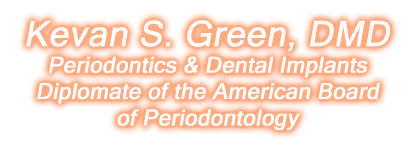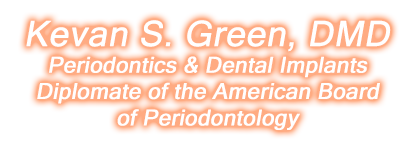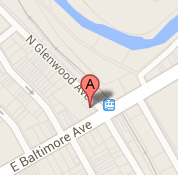
Periodontics
Initial Oral Examination
Your first visit at our office is very important in establishing your periodontal health baseline. Dr. Green will perform a complete periodontal evaluation, an analysis of your occlusion (bite) and a thorough examination of your teeth, their supporting structures and of the oral anatomy.
The Preventive Program
Both natural teeth and teeth with restorations survive best in an oral environment that is clean and where proper oral hygiene is maintained. Our dental hygiene program is designed to help prevent new cavities, preserve teeth that have been restored and manage periodontal disease. At the initial visit with our hygienist, oral hygiene instructions are reviewed and are reinforced at subsequent recall visits.
Scaling and Root Planing
Periodontal treatment methods depend upon the type and severity of the disease. We will evaluate the severity of each of our patients and recommend the appropriate treatment. Periodontal disease progresses as the sulcus (pocket or space) between the tooth and gums gets filled with bacteria, plaque, and tartar, which cause irritation to the surrounding tissues. When these irritants remain in the pocket, they cause infection and damage to the gums and eventually, the bone that supports the teeth. If the disease is caught in the early stages (known as Gingivitis) and no permanent damage has been done, one to two regular cleanings may be recommended. You will also be given instructions on improving your daily oral hygiene habits. However, if the disease has progressed to a more advanced stage, where the infection has caused bone loss, treatment options may include scaling and root planing, bone surgery or or other gingival and osseous treatments.
Pocket Reduction Surgery
Pocket reduction surgery (also known as gingivectomy, osseous surgery and flap surgery) is a collective term for a series of several different surgeries aimed at gaining access to the roots of the teeth in order to remove bacteria and tartar (calculus).The human mouth contains dozens of different bacteria at any given time. The bacteria found in plaque produce acids that lead to demineralization of the tooth surface, and ultimately contribute to periodontal disease.
Periodontal infections cause a chronic inflammatory response in the body that literally destroys bone and gum tissues once they invade the subgingival area (below the gum line). Periodontal disease is a progressive condition which, if left untreated, causes gingival inflammation and bone loss. Pocket reduction surgery is an attempt to alleviate this destructive cycle, and reduce the depth of the bacteria-harboring pockets.
Bone Grafts
During both periodontal and dental implant surgery, it may be necessary to perform bone grafting. The bone graft supplements the bone around existing teeth or in the case of implants, in the recipient site of the implant. The goal of the graft is to strengthen bone support for the existing tooth or to create a more stable base for the dental implant.Sinus Grafts
Dental implants need bone to hold them in place. When the sinus wall is very thin, it is impossible to place dental implants in this bone. There is a solution called a sinus graft or sinus lift graft. During this procedure, your periodontist enters the sinus from where the upper teeth used to be. The sinus membrane is then lifted upward and donor bone is inserted into the floor of the sinus. The sinus graft makes it possible for many patients to have dental implants when years ago there was no other option other than wearing partial dentures.
Crown Lengthening
Periodontal procedures are available to lay the groundwork for restorative and cosmetic dentistry and/or to improve the esthetics of your gum line. Crown lengthening can improve a "gummy" smile or fix decayed teeth, broken below the gum line, or has insufficient tooth structure for a restoration, such as a crown or bridge.
Gum Grafting
When recession of the gingiva occurs, the body loses a natural defense against both bacterial penetration and trauma. When gum recession is a problem, gum reconstruction using grafting techniques is an option. When there is only minor recession, some healthy gingiva often remains and protects the tooth, so that no treatment other than modifying home care practices is necessary. However, when recession reaches the mucosa, the first line of defense against bacterial penetration is lost. In addition, gum recession often results in root sensitivity to hot and cold foods as well as an unsightly appearance of the gum and tooth. When significant, gum recession can predispose to worsening recession and expose the root surface, which is softer than enamel, leading to root caries and root gouging. A gingival graft is designed to solve these problems. A thin piece of tissue is taken from the roof of the mouth or gently moved over from adjacent areas to provide a stable band of attached gingiva around the tooth. The gingival graft may be placed in such a way as to cover the exposed portion of the root. The gingival graft procedure is highly predictable and results in a stable healthy band of attached tissue around the tooth.
Extractions
When tooth removal is necessary, we can perform simple extractions using local anesthesia.
Atraumatic Dental Extractions
In order to preserve the alveolar bone surrounding a tooth that needs to be extracted, we use specialized instruments to eliminate or minimize the usual bone loss that can occur with traditional tooth extractions.


 Kevan S. Green, DMD
Kevan S. Green, DMD

